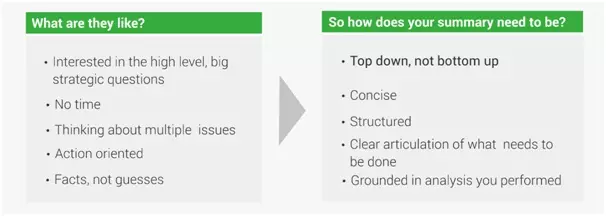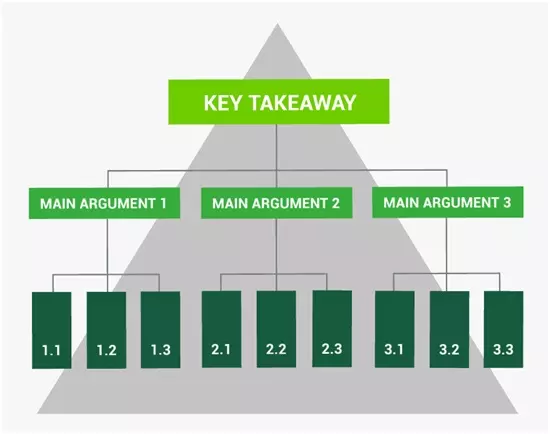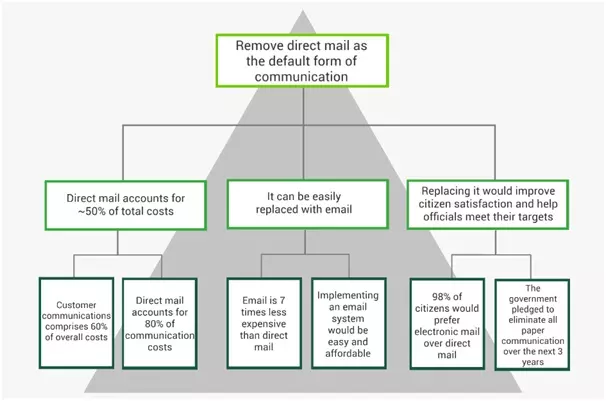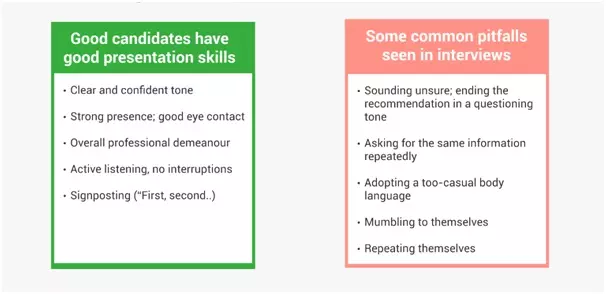The case interview does not end when you solve your problem. Even if you have put in a flawless performance across the previous three steps - accurately identifying the problem, building a perfect problem driven structure and efficiently leading the analysis to arrive at a solution - this will count for nought, though if you cannot properly explain to your interviewer what the business you are advising should now act.
This is precisely the same for a working consultant. All the analysis in the world is meaningless without being able to explain to the client what they need to do next.
So, you should avoid falling at the final fence! In this article, we teach you how to deliver a recommendation properly. First, we consider the audience for your recommendation so as to understand what characterises a good recommendation and why it must be made in such a characteristic way. Barbara Minto's famous pyramid principle is the keystone of our approach, but is not enough in itself and we will learn about how our recommendation should go beyond the pyramid structure. To finish, we also take some points on general communicative style.
As always, the most comprehensive resource on this topic is our full length video lesson on providing recommendations in the MCC Academy. This article is an excellent primer, but there is only so much we can pack into this compact format!
Demands
You might wonder why we need to give the act of providing client recommendations any real thought at all. Surely, it can't be very complicated to simply relay your findings?
Looking for an all-inclusive, peace of mind program?
Choose our mentoring programs to get access to all our resources, a customised study plan and a dedicated experienced MBB mentor Learn moreHowever, your case interview is supposed to be a simulation of real consulting work - and a working consultant has to give their own client recommendations in a very specific way. Your interviewer needs to assess whether you are equipped to do the same.
Communicating with CEOs
The necessities of how recommendations must be given ultimately stem from who they are being delivered to. CEOs are incredibly busy individuals, placing a high premium on their own time. They have hired a consultant to give them the answer to an important question so that they can direct their business appropriately. As such, recommendations must give CEOs what they are after, as clearly and concisely as possible - time is going to be your main limiting factor in delivering recommendations.
The table below summarises the traits typical of busy CEOs and the dos and don'ts of providing recommendations to this kind of audience.
Generally, you will need to adopt a "top-down" approach to providing recommendations, in that we should always begin from the one essential piece of information the CEO needs and then justify or provide more information as required. This relays salient information as efficiently as possible in a time pressured setting - the recommendation as a whole should ideally be kept to around 30 seconds.
Consulting vs. Academia
Whilst the idea of a top-down approach to communication might seem intuitive enough, many candidates will be coming from a background where they have been doing precisely the opposite. The "academic" style of communication - which those coming from university or research-based careers will be familiar with - starts from data, works through an argument and eventually delivers a conclusion at the end. This can be a source of major problems, as candidates default to a mode of communication and give rambling "bottom up" recommendations, full of largely irrelevant information and leaving the interviewer wondering when they will get to the point. It takes practice to learn to work the other way around!
All the best resources in one place!
Our platform is unique in collecting everything you need to ace your interview in one convenient location, for a truly joined up experience. Sign upFour Step Method
Following our four step method is the best way to ensure you give a great recommendation. The process might seem quite involved now, but will become second nature with a little practice.
The first three steps arrange the bulk of your recommendation around the Pyramid Principle, which you can read about in more detail in our dedicated article here. In the final step, though, we go beyond the pyramid structure to add other crucial pieces of information.
To see how this method actually applies, we'll work through a case example at the same time as we explain the theory.
Example: The Department of Good Citizenship
Let's say that you have been working on a case study about cost-cutting in a (somewhat Orwellian sounding) civil service department. Initially, you were given this prompt:
How should the Department of Good Citizenship cut costs in its service delivery?
Your analysis has revealed some interesting facts:
- Customer communications is the largest single cost, comprising 60% of total costs
- Direct mail is seven times more expensive than email and makes up 80% of communication costs
- Direct mail is the default form of communication currently
- 98% of all customers have indicated that they prefer electronic communication methods; we do not have demographic breakdown of respondents
Now, your interviewer prompts you to make a recommendation. What should you do next?
1. Key Takeaway
Your first step to delivering your recommendation is to establish a direct - ideally single sentence - answer to the main case question. This "key takeaway" is what the client really cares about - the answer they have paid thousands in fees to find out - and it needs to be the first thing out of your mouth. The key takeaway sits at the peak of Minto's pyramid, as per the diagram below:
The key takeaway must be pertinent and succinct - no waffle! You should be synthesising your findings, rather than simply summarising them. That is, rather than just restating facts, you need to boil these down into a single crucial directive for the client.
Join thousands of other candidates cracking cases like pros
At MyConsultingCoach we teach you how to solve cases like a consultant Get startedIn the case of the Department of Good Citizenship, the various findings we listed above (including the facts that direct mail is such a large fraction of costs and that customers prefer electronic communication) can be synthesised into the key takeaway that we should remove direct mail as the default form of communication.
2. Supporting Arguments
Now, moving to the middle layer of the pyramid structure, we need to offer some arguments to actually support our takeaway. Ideally, you should provide a group of three such arguments.
As with everything in the recommendation, these must be kept succinct. However, there are additional specific requirements which your arguments must meet:
- Independent - Each argument must stand on its own
- Fact Based - Arguments should avoid generic statements and must all be supported by facts
- MECE - The arguments should not overlap, whilst covering all of the key reasons supporting the takeaway. See our article on the MECE rule for more detail here.
- Level Consistent - Related to the MECE rule, the arguments must all be on the same level of analysis. Arguments on the same level should not be subsets other arguments on the same level.
For our civil service department, we could supply the following set of three supporting arguments:
- Direct mail accounts for around 50% of total costs
- Direct mail can easily be replaced by email
- Making this replacement would increase customer satisfaction
3. Insights
At the bottom of the pyramid, we find what is effectively the data substantiating the arguments which in turn support our key takeaway. In this level have one or two "insights" associated with each of our arguments at the level above. These insights might be facts or further arguments.
For example, to substantiate our argument above that direct mail accounts for around 50% of total costs, we could provide the insights that:
- Customer communication comprises 60% of overall costs
- Direct mail accounts for 80% of communication cost
Once we have added all these insights, our pyramid is complete and is shown below:
4. Adapt your Summary
You might have filled in your pyramid structure, but you are not quite ready to deliver your recommendation yet. As with everything in your case interview, you must be sure that you are adapting your answers to the specifics of the scenario you are dealing with. Following the first three steps here will yield a good recommendation, but not a fantastic one.
There are a few ways you might go about adapting your recommendation to the particular scenario you are working with. These are shown in the table below, along with reasons why you might want to include them and where they would fit into your recommendation.
You are not aiming to make all the kinds of addition above in every recommendation you make. Typically, you will only add one or two, with everything depending upon the specifics of the case.
Everything you need in one place
All the most up-to-date resources delivered as a MBA course Learn moreUp to this point, you have put a significant amount of effort into being concise. Don't blow it now! You should limit what you add in this step to a total of a few sentences - no more than one or two each.
In our example, we might take note of a major risk stemming from the fact that our survey was conducted entirely online, so it might have missed out on the views of population segments - such as the elderly - who are less electronically savvy and might rely on direct mail. We might thus recommend that our next step should be to conduct a more comprehensive survey, targeting all population segments.
The Final Recommendation
In our example, then, the final recommendation we will be delivering to the Department of Good Citizenship is the following:
To reduce costs in service delivery, the Department should consider removing direct mail as the default form of communication. They should do this for three reasons.
First, Direct mail is the largest cost driver within the biggest cost category. This single activity makes up nearly 50% of all costs.
Second, The Department could switch to using electronic mail instead, which is 7 times less expensive and can be quickly implemented at a negligible cost.
Third, the Department would increase customer satisfaction and help the government meet its carbon footprint targets. Our survey shows that citizens would prefer electronic mail, whilst the government wants to eliminate paper communication within 3 years.
However, there are some risks accompanying this strategy. It's possible that only the electronically savvy responded to the online survey, and we are missing the viewpoints of those who would rely on direct mail - such as some elderly citizens. Targeting direct mail is still the most promising option for now, but a more comprehensive needs survey should be conducted before implementation.
Style
By style, we don't mean what you're wearing, but rather how you behave and "hold yourself" as you deliver your recommendation. We could discuss the nuances of personal presentation all day, but here is a convenient table covering most important "dos and don'ts".
Of course, many of these points are just as relevant to the rest of both your case and fit interviews.
Given how much of consulting involves working with others, your interpersonal skills will be just as crucial as your math and reasoning in landing an MBB job!
What next?
Learning how to deliver client recommendations is the fourth and final stage in our case solving process (if you have not read the other articles in this series yet, start here). Now you are familiar with the core of our case cracking system, you should be practicing cases to bed down your new skills. Of course, these compact articles can only pack in so much material. The truly comprehensive resource remains our video lessons in MCC Academy, where time allows us to dive into deeper detail on crucial points and to include more worked examples to help you get to drips with applying concepts.
It is always important to remember the bigger picture, in that your consulting interviews will not only be about solving cases. Your performance in the "fit interview" is just as important as is your case cracking ability. Luckily, My Consulting Coach has you covered, with our handy articles and a full video course.








